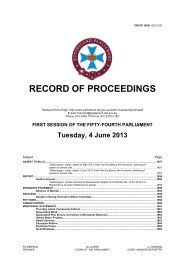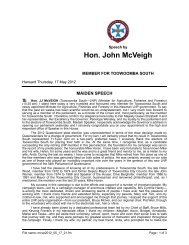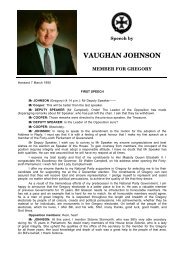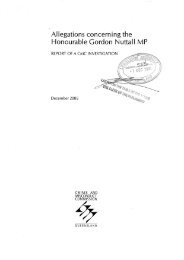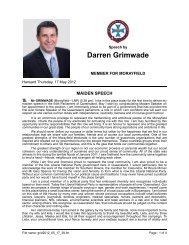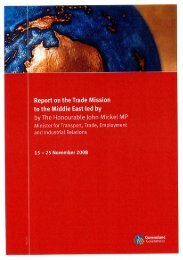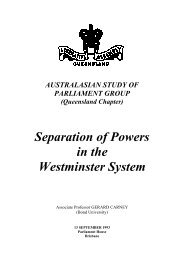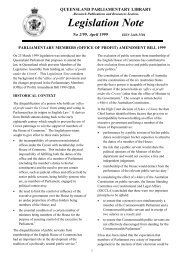weekly hansard - Queensland Parliament - Queensland Government
weekly hansard - Queensland Parliament - Queensland Government
weekly hansard - Queensland Parliament - Queensland Government
Create successful ePaper yourself
Turn your PDF publications into a flip-book with our unique Google optimized e-Paper software.
2638 Child Safety Legislation Amendment Bill 23 Aug 2005<br />
Keeping our children safe requires constant vigilance on the part of community, teachers, health<br />
workers, police and, basically, all who have contact with children. Sadly, we live in a world where such<br />
things as relationship breakdowns, domestic violence, drug taking, mental illness, financial stress and<br />
so many others can place children in danger from adults. Very sadly, often that adult is a parent.<br />
However, this child safety legislation has at its very heart and its paramount principle to do what is in the<br />
best interests of the child.<br />
Many times it has been demonstrated that given love, encouragement, nurture and support<br />
children can respond and be healed. Foster-parents have big hearts. I want to commend the hundreds<br />
of parents and individuals who have love and care to share with those children who often need a lot of<br />
extra reassurance and love. There are many people involved in caring for those children. In closing, I<br />
would like to congratulate the minister, our department and the vast number of people who just look out<br />
for others, especially little people. I commend the bill to the House.<br />
Mrs STUCKEY (Currumbin—Lib) (9.15 pm): I rise in the House tonight to foreshadow the Liberal<br />
Party’s support for the third stage of the legislative reform program of the Child Safety Legislation<br />
Amendment Bill for the implementation of the Crime and Misconduct Commission’s report Protecting<br />
children: an inquiry into abuse of children in foster care.<br />
From the outset I state that the second stage of these reforms, which were passed in the House in<br />
October 2004, are yet to be fully implemented. It is to be hoped that this third stage of reforms is<br />
employed more swiftly. I request the minister to provide the House with a time frame for the<br />
implementation of the third stage of these reforms.<br />
This bill is aimed at closing gaps in the Child Protection Act 1999 and includes regulating<br />
voluntary placements, the assessment and approval of all carers, consultation with recognised<br />
Indigenous entities and refining Indigenous child placement principles. Realistically, though, from the<br />
countless media articles concerning the Department of Child Safety it would appear that there are still a<br />
number of cracks that the state government needs to glue together as a matter of urgency. While I do<br />
appreciate that the new Department of Child Safety was born a mere 18 months ago and, like any<br />
toddler, will no doubt experience teething problems, it is imperative that we remember that the Premier<br />
stated his reason for calling the 2004 election was the promise of putting children first. This promise has<br />
not been fulfilled according to some industry stakeholders.<br />
In fact, over the past several months it has been widely reported that many community<br />
organisations working in the area of child protection feel that the children of <strong>Queensland</strong> are no better<br />
off than before the 2003 CMC inquiry into foster care. In March of this year, the Courier-Mail reported<br />
that <strong>Queensland</strong> admitted more children to care than any other state but spent less than the national<br />
average on their management. There is no dispute that the state government has injected a<br />
large amount of money into this area, but most of that money went into establishing the new Department<br />
of Child Safety and did not filter through to the grassroots level of helping children in need.<br />
This scarcity of help at the grassroots level could not be more evident than in figures from the<br />
Toowoomba and Ipswich offices, as reported by the Courier-Mail in April 2005. The Toowoomba Child<br />
Safety Service Centre had 432 unallocated initial assessments awaiting action. That is nearly double<br />
the number of 220 reported as outstanding in November 2004. Down the range, the Ipswich office was<br />
struggling to investigate 100 new notifications a month. In March the team had a backlog of 376 cases,<br />
with 157 not even having a case officer allocated. If service centres are only getting an estimated one<br />
and a half extra employees, a large number of vulnerable children will still be left in undesirable if not<br />
unsafe situations.<br />
Other concerns draw attention to the failure to deal with priority 1 cases within the 24 hour<br />
requirement. Those cases are generally related to a child being at high risk of sexual abuse, violent<br />
abuse, torture or suicide. In the December 2003 quarter, the department received 3,668 notifications<br />
involving 6,822 children, compared to the December 2004 quarter in which there were 589 notifications<br />
involving 9,791 children. This is a staggering 39 per cent increase in notifications and an even greater<br />
43 per cent increase in the number of children coming into contact with the department. Recently, 140<br />
community organisations involved in child protection said that the system was geared up to be punitive<br />
rather than preventive. Notifications were increasing and record numbers of children were being taken<br />
into care.<br />
These are serious allegations being raised, and the state government needs to listen to this and<br />
respond accordingly, not simply use the mantra that organisations are being unfair in their criticisms and<br />
that the department is on track with its three-year reforms. This whole system failed children miserably<br />
in the past, and we owe it to children to protect them with active and effective legislation.<br />
I do commend the amendment of clause 4 in part 2 of the act to provide for kinship carers.<br />
Kinship carers include not only relatives of significance to the child but also persons of significance to<br />
that child. This definition departs from the narrow concept of relative and is much more culturally<br />
inclusive and in sync with today’s changing family structures and should be the preferred option in terms<br />
of the child’s emotional stability.



